Click on images to enlarge
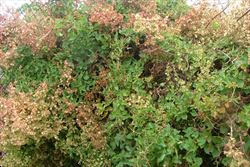
habit growing on a fence (Photo: Sheldon Navie)
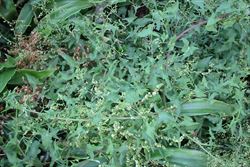
habit scrambling over other plants (Photo: Sheldon Navie)
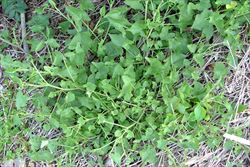
creeping habit in the early stages of growth from underground tubers (Photo: Sheldon Navie)
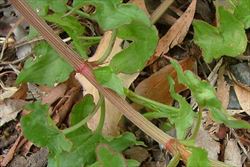
close-up of the slightly-ribbed reddish stems (Photo: Sheldon Navie)
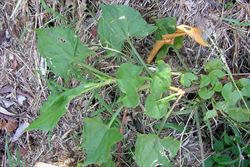
lower leaves, which are often somewhat broader and less pointed (Photo: Sheldon Navie)
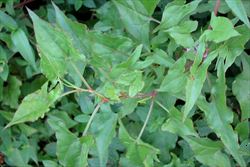
narrower upper leaves, with more prominent basal lobes (Photo: Sheldon Navie)
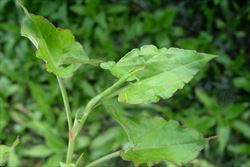
the margins of the leaves are sometimes reddish in colour and wrinkled (Photo: Sheldon Navie)
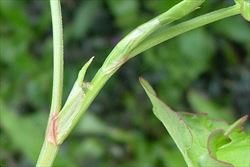
close-up of the leaf bases showing the winged petiole that forms a sheath-like structure (Photo: Sheldon Navie)

close-up of bright green leaf with slightly indented veins (Photo: Sheldon Navie)
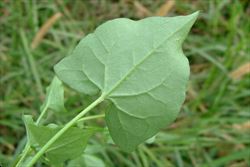
paler leaf underside with more prominent veins (Photo: Sheldon Navie)
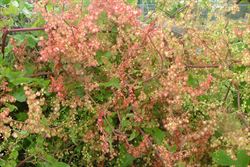
the flowers and fruit are borne in large branched clusters at the tips of the stems (Photo: Sheldon Navie)
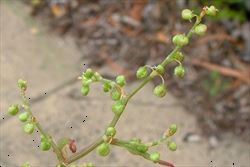
close-up of the tiny greenish-coloured flowers (Photo: Sheldon Navie)
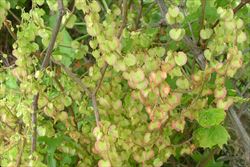
young fruit beginning to develop (Photo: Sheldon Navie)
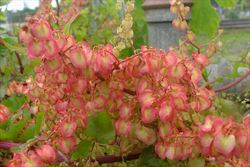
the papery fruit turn pinkish-red in colour, particularly near their margins, as they begin to mature (Photo: Sheldon Navie)
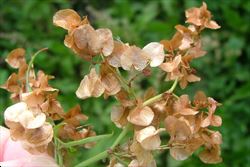
mature fruit eventually turn pale brown in colour (Photo: Sheldon Navie)
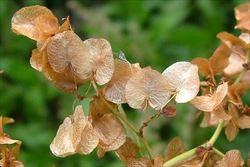
close-up of the mature fruit, each with three conspicuously veined wings (Photo: Sheldon Navie)
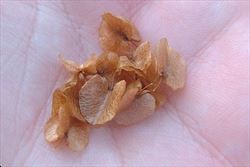
close-up of the mature fruit, each with three conspicuously veined wings (Photo: Sheldon Navie)
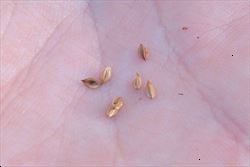
close-up of seeds (Photo: Sheldon Navie)

close-up of the mature fruit, each with three conspicuously veined wings (Photo: Sheldon Navie)

close-up of seeds (Photo: Sheldon Navie)
Scientific Name
Acetosa sagittata (Thunb.) L.A.S. Johnson & B.G. Briggs
Synonyms
Rumex sagittatus Thunb.
Family
Polygonaceae
Common Names
arrow dock, arrowhead, arrow-head vine, arrowhead vine, climbing dock, climbing sorrel, potato vine, rambling dock, red sorrel, turkey rhubarb, turkey rhubarb vine, turkey-rhubarb
Origin
Native to southern Africa (i.e. parts of South Africa, Namibia, Lesotho and Swaziland).
Cultivation
This species is generally not deliberately cultivated in Australia anymore, though it may have been originally introduced as a garden ornamental. However, because of its colourful fruit, it is occasionally still sold at markets.
Naturalised Distribution
Naturalised in south-eastern Queensland, in the coastal and sub-coastal districts of eastern New South Wales, in southern Victoria, in south-eastern South Australia, in Tasmania, and near Perth in south-western Western Australia.
Rambling dock (Acetosa sagittata) is most commonly found in the south-eastern parts of Australia and is particularly abundant around major urban centres such as Sydney, Melbourne and Brisbane. It is relatively widespread and common in the coastal and sub-coastal areas of New South Wales and south-eastern Queensland. In Victoria it is rather common in the inner and eastern bayside suburbs of Melbourne and is occasional in the south-eastern parts of the state (e.g. in the Dandenong Ranges in the Eastern Highlands, at Erica on the Gippsland Plain, and at Lakes Entrance in East Gippsland). It is less widespread in South Australia and Tasmania. In South Australia it is only present near Adelaide and in the extreme south-east of the state, while in Tasmania it is only known to occur locally on Flinders Island, in the north-west of the state and in the Hobart area. There are also a few records of this species becoming naturalised in gardens in Perth in south-western Western Australia.
This species is also naturalised in New Zealand (particularly on the North Island).
Habitat
A weed of gardens, fences, hedges, rock walls, railway lines, roadsides, waste areas, disturbed sites, cultivation, urban bushland, waterways (i.e. riparian areas), moist gullies, open woodlands, closed forests and coastal habitats (e.g. hind-dunes and coastal shrublands) in temperate and sub-tropical regions. It tends to favour damp or seasonally moist sites and prefers sandy soils.
Habit
A long-lived (i.e. perennial) scrambling plant with a creeping (i.e. prostrate) habit or a low climber with short-lived stems reaching up to 3 m long (occasionally up to 5 m long). The stems usually sprout from long-lived underground tubers each spring and die back during as the weather gets cooler and/or drier (i.e. in winter). However, plants may continue to grow year-round in warmer climates.
Distinguishing Features
- a scrambling creeper or low climber with short-lived stems that grow each year from long-lived underground tubers.
- its stems are prominently ribbed and green or reddish-green in colour.
- its alternately arranged leaves are distinctively arrow-shaped and are often slightly fleshy in nature.
- its small greenish flowers are inconspicuous, but its bright reddish-pink immature fruit are very distinctive.
- these papery, three-winged, fruit turn pale brown as they mature and are borne in large cascading clusters.
Seedling
Seedlings have two seed-leaves (i.e. cotyledons) that are egg-shaped in outline (i.e. ovate) or oval (i.e. elliptic) in shape. Many plants that emerge each spring are actually not seedlings, but re-growth from the underground tubers, and so do not have any seed leaves.
Stems and Leaves
The stems are somewhat fleshy in nature (i.e. succulent) and originate from large underground tubers that may be 10 cm or more long. These tubers are brown in colour on the outside and yellowish inside, and resemble a beetroot or sweet potato. Tubers are usually connected to one another by thin underground stems (i.e. rhizomes) that resemble roots. The aboveground stems are hairless (i.e. glabrous) and prominently ribbed. They are initially green or reddish-green in colour, but older stems usually turn pale brown and may become slightly woody in nature.
The soft bright green leaves (2-10 cm long and 1-7 cm wide) are borne on stalks (i.e. petioles) 15-70 mm long. These leaves are hairless (i.e. glabrous), slightly fleshy (i.e. semi-succulent), and alternately arranged along the stems. They are very distinctive because of their triangular or arrowhead-shaped appearance, with each leaf usually having two backwards-pointing lobes at its base (i.e. a sagittate base) and a pointed tip (i.e. acute apex). The leaf margins are usually wavy (i.e. undulating) or slightly curled (i.e. crisped) and the very edges of the leaves are sometimes reddish in colour when plants are growing in a sunny position. The upper leaf surfaces have slightly sunken veins, while the undersides of the leaves are slightly paler green in colour and have more prominent veins. The base of each leaf stalk (i.e. petiole) also has dilated margins that form a see-through membranous sheath called an 'ochrea' which usually encloses part of the stem.
Flowers and Fruit
The small greenish or greenish-white coloured flowers are borne on very slender stalks (i.e. filiform pedicels). These stalks have a joint about half-way along them (i.e. they are articulated) and eventually grow to about 5-6 mm long when the fruit are mature. The flowers are arranged in small groups (i.e. in few-flowered whorls) along large, loose, multi-branched clusters up to 30 cm long at the tips of the stems (i.e. in terminal panicles). Each flower has three tiny 'sepals' and three 'petals' (i.e. inner and outer perianth segments) that are about 1 mm long when the flower opens. They also have six tiny stamens and three styles bearing very elongated stigmas (occasionally the stamens may be absent as some flowers are female). The outer perianth segments remain small and membranous as the fruit develops, while the inner perianth segments become enlarged and enclose the fruit (they are then called valves). Flowering occurs during late spring and summer (i.e. from November to April).
The fruit is a small nut surrounded by three papery wings (i.e. valves) 4-7 mm long and 6-10 mm across that have conspicuous veins. These fruit are initially green in colour but usually turn bright pinkish-red or purplish as they mature (particularly near their margins) and are often mistaken for the flowers of this species. The fruit finally turn pale brown in colour when they reach full maturity, usually during summer, and are dispersed from the plant in late summer and autumn. Each fruit contains a single seed within the small three-sided nut (about 3 mm long and 1.7 mm wide). These nuts are light brown in colour and shiny in appearance.
Reproduction and Dispersal
This plant reproduces by seed and also via underground tubers and creeping underground stems (i.e. rhizomes).
The seeds are dispersed in the light papery fruit, which are easily spread by the wind and float on water. They may also be dispersed by slashing. The seeds, tubers and rhizomes may also be spread in dumped garden waste or contaminated soil. Tubers and rhizomes can also be dislodged and spread downstream during floods.
Environmental Impact
Rambling dock (Acetosa sagittata ) is regarded as a significant environmental weed in New South Wales and Victoria and as an environmental weed in Queensland.
This species is a major weed of gardens and urban bushland in south-eastern Australia. It grows very vigorously during spring and summer and is capable of completely smothering the ground flora and smaller shrubs with its prolific growth. This can prevent the regeneration of native species and eventually reduce the biodiversity in invaded sites. Rambling dock (Acetosa sagittata) can be difficult to control because it is a prolific seeder and regenerates from underground tubers if the top growth is removed. The underground tubers can be very difficult to locate and remove when attempting to control infestations of this species, and it is important that seed capsules and tubers are disposed of carefully to prevent them being spread.
Rambling dock (Acetosa sagittata) causes most concern in New South Wales and has been declared in some areas (i.e. in northern Sydney) because of its impact as an environmental weed. It is especially common around urban areas and in waste areas near towns. Hence, it appears on many environmental weed lists in the Sydney area (e.g. in Sutherland Shire, Randwick City, Manly Council, Lake Macquarie City, Blue Mountains City, the Sydney Central region, the Sydney North region, and the wider Sydney and Blue Mountains region). In one study, at Wahroonga in the northern Sydney area, rambling dock (Acetosa sagittata) was found to be one of the most common exotic species growing in a sclerophyll woodland, and was primarily located in areas that were nutrient-enriched by run-off from nearby residential developments. Though fire may sometimes be used in such areas as a tool for controlling exotic weeds, it was found that rambling dock (Acetosa sagittata) could maintain its presence post-fire through vegetatively re-sprouting from its underground tubers.
This species is also threatening the survival of endangered native plant species. For example, the native she-oak Allocasuarina portuensis only occurs naturally in foreshore vegetation in Nielsen Park, within the Sydney Harbour National Park. Rambling dock (Acetosa sagittata) was one of six invasive weed species dominating the understorey vegetation of this site, and it is thought that the dense groundcover of weeds may be preventing the regeneration of this endangered species.
Rambling dock (Acetosa sagittata) is also one of the highest priority environmental weeds at the regional level on the north coast of New South Wales, mainly due to its impact in coastal and near-coastal areas. In particular, it is a common weed of coastal rainforests, where it is known to form thick mats on the forest floor. It is a problem in coastal areas in the south of the state too, including in the Eurobodalla National Park. Rambling dock (Acetosa sagittata) is also listed as one of the main weed species of concern on Montague Island, a conservation reserve just off the coast of southern New South Wales. Here rambling dock (Acetosa sagittaria) occurs in large patches and has been reported to displace native plants. In the Southern Foreshore Reserve at Narrawallee Beach, in the Shoalhaven City Council area, this species is dominating large areas of the ground layer of the hind-dune vegetation and is seen as a major long-term management problem in this reserve.
In Victoria, rambling dock (Acetosa sagittata ) has mostly been seen as a problem in coastal or near-coastal shrublands and along waterways near Melbourne and in the east of the state (e.g. in the Kananook Creek area on the Mornington Peninsula). However, it is now thought that the actual distribution of this species may be more widespread than previously recognised, and that it is likely to continue to spread in coastal areas in the future.
This species was also recently ranked in the top 100 in a list of the most invasive plants of south-east Queensland. However, in Western Australia it is a relatively recent introduction and at present it is primarily a weed of gardens in the Perth area.
Legislation
This species is declared under legislation in the following states and territories:
- New South Wales: Class 4 - a locally controlled weed. The growth and spread of this species must be controlled according to the measures specified in a management plan published by the local control authority and the plant may not be sold, propagated or knowingly distributed (in the Hornsby, Ku-ring-gai, Lane Cove, North Sydney, Pittwater, Warringbah and Willoughby local authority areas only).
- Western Australia: Unassessed - this species is declared in other states or territories and is prohibited (throughout the entire state) until assessed via a weed risk assessment.
Management
For information on the management of this species see the following resources:
- the New South Wales Department of Primary Industries Noxious and Environmental Weed Control Handbook, which is available online at http://www.dpi.nsw.gov.au.
- the Turkey Rhubarb page on the Sydney Weeds Committee website at http://www.sydneyweeds.org.au/.
- the South Coast Weeds website at http://www.esc.nsw.gov.au/Weeds/index.asp.
- the Sutherland Shire Weed Fact Sheet on this species, which is available online at http://www.sutherland.nsw.gov.au.
- the Randwick City Environmental Weed Profile on this species, which is available online at http://www.randwick.nsw.gov.au.
Similar Species
Rambling dock (Acetosa sagittata) is usually easily distinguished by its leaves and fruit. However, closely related weeds such as rosy dock (Acetosa vesicaria) and climbing buckwheat (Fallopia convolvulus) are reasonably similar when not in flower and coral vine (Antigonon leptopus) may appear similar when its fruit are mature. Slender lignum (Muehlenbeckia gracillima), a native plant, has very similar stems and leaves and also has a similar distribution. These species may be distinguished by the following differences:
- rambling dock (Acetosa sagittata) is a scrambling or climbing plant with slightly fleshy, arrowhead-shaped (i.e. sagittate) leaves that lack prominent veins. Its flowers are initially greenish in colour and are borne in large branched clusters at the tips of the stems (i.e. in terminal panicles). These flowers become pinkish or reddish in colour and later turn light brown and become papery as the fruit mature. It is a long-lived (i.e. perennial) plant that produces underground tubers.
- rosy dock (Acetosa vesicaria) is an upright (i.e. erect) plant with slightly fleshy, arrowhead-shaped (i.e. sagittate) leaves that lack prominent veins. Its flowers are initially greenish in colour and are borne in large branched clusters at the tips of the stems (i.e. in terminal panicles). These flowers become pink or bright red in colour and develop a bladdery appearance as the fruit mature. It is a short-lived (i.e. annual) plant that does not produce underground tubers.
- climbing buckwheat (Fallopia convolvulus) is a scrambling or climbing plant with arrowhead-shaped (i.e. sagittate) leaves that lack prominent veins. Its flowers are greenish in colour and are borne in small clusters in the leaf forks (i.e. in axillary clusters or spikes). These flowers turn dark brown or black in colour as the small three-sided fruit mature. It is a short-lived (i.e. annual) plant that does not produce underground tubers.
- coral vine (Antigonon leptopus) is a climbing plant with heart-shaped (i.e. cordate), egg-shaped (i.e. ovate) or somewhat triangular leaves that have a prominent network of veins and a somewhat wrinkled surface (i.e. they are rugose). Its flowers are usually bright pink in colour (rarely white) and are borne in large branched clusters at the tips of the stems (i.e. in terminal panicles). These flowers turn light brown as the fruit mature. It is a long-lived (i.e. perennial) plant that produces underground tubers.
- slender lignum (Muehlenbeckia gracillima) is a scrambling or climbing plant with arrowhead-shaped (i.e. sagittate) leaves that lack prominent veins. Its inconspicuous flowers are greenish in colour and are borne in elongated clusters in the leaf forks (i.e. in axillary spikes or racemes). These flowers turn black in colour as the small rounded and slightly wrinkled fruit mature. It is a long-lived (i.e. perennial) plant that does not produce underground tubers.
Rambling dock (Acetosa sagittata ) is commonly called "turkey rhubarb" in many parts of Australia, however it should not be confused with another species that is also given this common name (i.e. Rheum palmatum). Turkey rhubarb (Rheum palmatum) is occasionally grown as a garden herb for its powerful purging properties, however it looks quite different to rambling dock (Acetosa sagittata).

